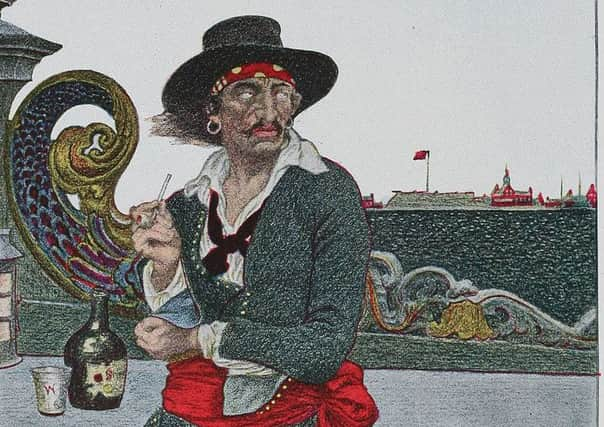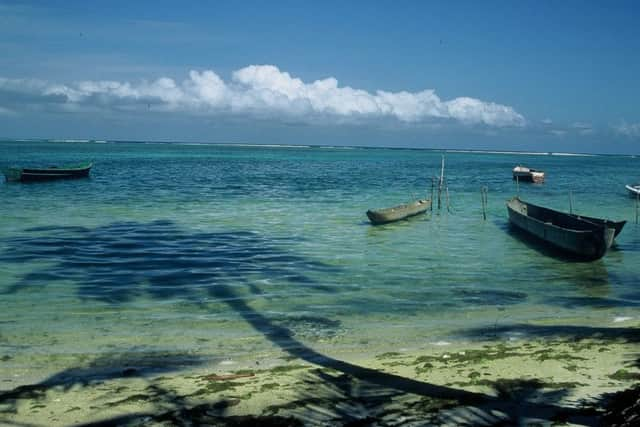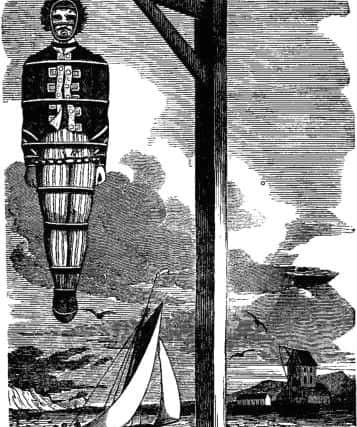The brutal end of Greenock's '˜Treasure Island' pirate


It is said Captain Kidd was inspiration of Robert Louis Stevenson’s Treasure Island with booty hunters still in pursuit of his missing cargoes to this day.
A 50kg bar of silver was found near the wreck of his ship Adventure Galley, off Madagascar, just last year.
Advertisement
Hide AdAdvertisement
Hide AdCaptain Kidd’s 20-year command of the high seas came to and end in 1701 when he was dipped in tar and hanged at the docks of Wapping.


He had been put to death for murder and piracy after being hired by government figures in the English colony of New York to raid ships in the Indian Ocean for their gain.
As his conduct on the ill-fated voyage was called into question - and the establishment sought to distance themselves from him - Captain Kidd’s body was displayed for two years on the dockside as a deterrent to other sea raiders.
Born in 1645 in Greenock - others claim Dundee - Captain Kidd first started out on the Blessed William as a privateer, effectively a legal pirate during times of conflict, in the Caribbean at the end of the 1680s.


By 1691, he was New York living in a town house in Wall Street having married a wealthy widow. Kidd rapidly became a member of the city’s elite given his new-found means and his involvement in the cotton and tobacco trade with Britain.
Piracy, however, was inflicting serious damage on trade routes of the day with Earl of Bellmont, The Governor of New York and Massachusetts, organising the financing of a ship to take on the raiders.
Captain Kidd was the man to take the vessel, the Adventure Galley, across the Atlantic and the Indian Oceans to take out pirates and French vessels in the area.
Advertisement
Hide AdAdvertisement
Hide Ad

It was a high stakes mission, with great financial gain to be had from booty taken from the target ships.
According to some accounts, even King William III stood to gain one tenth of the value of anything taken.
The Adventure Galley, equipped with 34 canons and a crew of 150, set sail form Deptford on September 6 1696 but Captain Kidd’s hand- picked crew were seized for service on HMS Duchess.
To make up numbers, sailors were taken from the harbour taverns of New York.


Captain Kidd’s reputation started to unravel as the voyage got underway. He abandoned three English vessels, belonging to the East India Company, which he had been due to escort to Cape Town.
The boat’s financiers became increasingly agitated when he attacked two vessels under English protection. Then, Cholera swept his boat, killing a third of his crew, with the replacement sailors and existing men becoming increasingly mutinous.
During a fight, Captain Kidd killed a gunner called Moore by hitting him with a wooden bucket.
Advertisement
Hide AdAdvertisement
Hide AdMore blunders followed as The Adventure Galley attacked boats on completely benign voyages.
Captain Kidd, however, was to make a breakthrough with the capture of the 300 ton Quetta Merchant and The Maiden
Both carried documents which confirmed the vessels were under French authority to attack British vessels. It should have been his finest hour but Captain Kidd further enraged his backers by going against their instructions and sharing £10,000 of proceeds from the booty among his men.
Fears that he had turned from pirate hunter to pirate were growing, not least because Captain Kidd then anchored in Ile St Marie off Madagascar, often referred to as Pirate Island. The world’s only pirate graveyard can be found here.
By now the Adventure Galley was barely seaworthy with the vessel starting to break up in its waters.
It soon became known that the British had announced an amnesty for every pirate in the Indian Ocean - apart from himself.
As public opinion started to turn against privateering and the establishment stake in the voyage of the Adventure Galley, manoeuvres were made to distance the government’s role in the voyage,
Advertisement
Hide AdAdvertisement
Hide AdThe papers which Captain Kidd seized from the Quetta ‘disappeared’ with their whereabouts unknown until 200 years later.
The documents, which could have been his key line of defence in his trial, were to evade him,
Kidd was taken to Britain in February 1700 and appeared at the House of Commons the following month.
His trial in May 1701 on two counts of piracy and one of murder was a foregone conclusion, and on 23 May 1701 he was hanged.
Meanwhile, treasure hunters continue to piece together the legacy of this Scottish pirate in the warm waters of the Indian Ocean.
